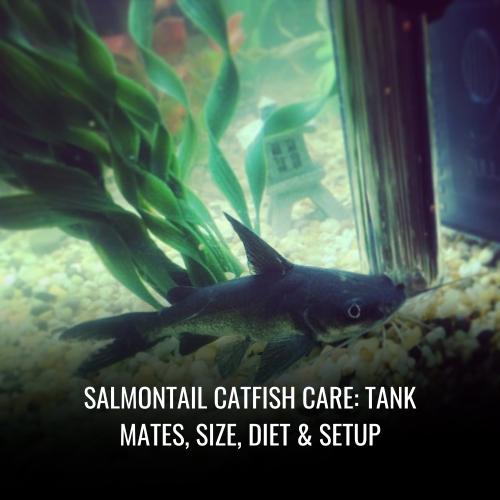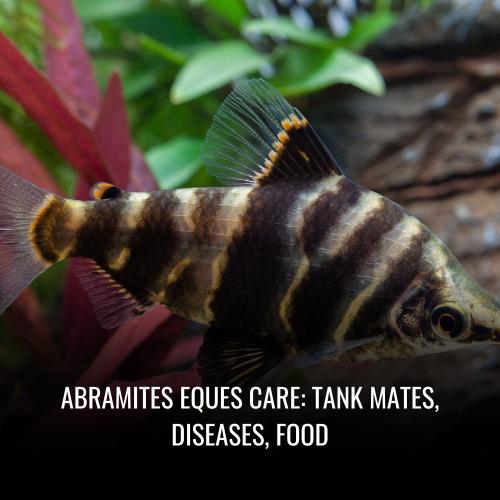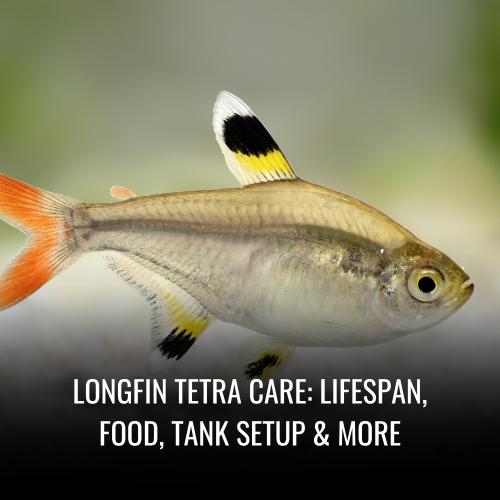The Elegant Cory, scientifically known as Corydoras elegans, is a small-sized freshwater fish native to South America. With a lifespan of around 5 years, these little beauties can bring joy to your tank for years to come. Their natural habitat consists of slow-moving streams and rivers with sandy or muddy bottoms, and they are known for their striking appearance and gentle behavior.
| Attribute | Information |
|---|---|
| Scientific Name | Corydoras elegans |
| Common Name | Elegant Cory |
| Family | Callichthyidae |
| Usual Size in Fish Tanks | 2.5 inches (6 cm) |
| Recommended pH Range | 6.0 – 7.5 |
| Recommended Water Hardness | 2 – 18 dGH |
| Recommended Temperature | 72°F – 78°F (22°C – 26°C) |
| Reproduction | Egg layer, often scatter their eggs |
| Origin | South America |
| Temperament to Own Species | Peaceful, prefers to be in groups |
| Temperament toward Others | Peaceful, compatible with most species |
| Usual Place in Tank | Bottom dwellers, prefer sand substrate |
| Lifespan | 5 – 8 years |
| Tank Size Requirement | Minimum 10 gallons (38 liters) |
| Filtration System | Gentle filtration, prefers low flow |
| Sexual Dimorphism | Females are usually larger and wider |
| Substrate Cleaning | Effective scavengers, help keep the substrate clean |
The Elegant Cory, also known as the Elegans Cory Cat, graces the freshwater aquarium with its tranquil presence. Found in the forest streams of the western Amazon, these peaceful catfish share a unique reticulated pattern with a distinct black stripe.
A harmonious addition to a community tank, the Elegant Cory thrives in a sandy substrate environment, mimicking its natural habitat. They often sift through sand to find food, making a specific sandy corner in the tank essential. Mature soft water aquarium conditions, with a focus on water hardness and cooler water temperatures, are aligned with their natural shallow water habitats.
Aquarium Care Tips:
- Maintain groups of 5+ for social harmony.
- Ensure smooth sand substrate for food foraging.
- Provide broad-leaved plants for spawning.
- Monitor water parameters closely.
Scientific Name
The Elegant Cory, scientifically known as Corydoras elegans, a small and charming member of the Callichthyidae family, is scientifically recognized as Corydoras elegans. This peaceful fish is native to South America, dwelling primarily in the freshwater bodies of the Amazon River’s upper basin, exploring the frontiers of Brazil, Colombia, and Peru through its tributaries and floodplains.
To maintain harmony within the aquarium and mirror their natural behavior, it is essential to house these fish in schools of at least six. Such a grouping will allow the Elegant Cory to exhibit its social tendencies, adding not only liveliness but also a dynamic visual element to the tank environment. When considering water chemistry, aim to maintain a pH range between 6.0 and 7.6, which is ideal for supporting the health and well-being of C. elegans.
Average Size
The Elegant Cory, recognized scientifically as Corydoras elegans, touts a modest size that enhances its appeal among aquarium enthusiasts. On average, these diminutive catfish attain lengths ranging from 1 inch to a comforting 2.5 inches as adults. Initially, when introduced to a new home, they are typically shipped at about 1 inch, showcasing their potential to grow within their aquatic environment.
Despite their small stature, the Elegant Cory is ideal for crafting a serene and spirited display in peaceful community aquariums. They are particularly suitable for tanks with a minimum capacity of 20 gallons, offering ample space for their playful antics and social interactions. Furthermore, adult Elegant Corydoras have a growth ceiling at approximately 2 inches, cementing their status as a relatively small but delightful species of fish. Their presence adds a touch of elegance and entertainment to any tank they grace.
Lifespan
The Elegant Cory, scientifically named Corydoras elegans, boasts a life expectancy that can reach a decade under optimal conditions, with many living comfortably for about five years. These enchanting fish, common in the tropical fishkeeping community, bring years of enjoyment to aquarists with their sociable and active demeanor.
Quick Facts:
- Typical Lifespan: ~5 years
- Maximum Lifespan: Up to 10 years
- Common Size at Purchase: 3/4 to 1-1/2 inches
Upon entering the aquarium, juvenile Elegant Corydoras are often found at sizes ranging from 3/4 to 1-1/2 inches. Fish keepers should take note of this when planning longevity-based tank dynamics. To fully benefit from their potential lifespan, providing a well-maintained environment that caters to their needs is crucial. This includes maintaining proper water parameters, providing a balanced diet, and ensuring a friendly social setting with a group of at least six individuals. Such attentive care is crucial for these elegant creatures to flourish and delight their owners year after year.
Natural Habitat
The natural environs of the Elegant Corydoras or Cory Cat span a variety of substrates. These intriguing catfish hail from settings rich in mud, smooth sand, and even rocky bottoms, demonstrating their versatile nature. In such habitats, their distinctive behavior becomes apparent—a playful sifting through the substrate as they search for food. It’s not uncommon to see them enthusiastically burying their faces into fine sand, adding a touch of whimsy to the tank.
What sets these catfish apart, though, is not just their environment or feeding antics but also their surprising respiratory habit. Elegant Corys are known to gulp fresh air from the water’s surface. This intriguing action involves a swift dart to the surface, a quick breath, and an equally rapid return to the safety of the substrate.
Natural Habitat Characteristics
- Substrate Type: Mud, Sand, Rocks
- Behavioral Traits: Substrate sifting, midwater shoaling
- Oxygen Intake: Gulp atmospheric air from the surface
- Preferred Environment: Shaded areas with driftwood, rocks, plants
- Tankmates: Peaceful species like pencilfish, tetras, and rasboras
Appearance
The Elegant Corydoras, known for their distinctive visage, showcases a sleek, slender form that’s hard to miss. Two striking dark longitudinal stripes run down their body, set against a captivating olive backdrop intermixed with gray and black markings. Their slim body structure is more elongated relative to their height, setting them apart from their Corydoras kin.
A closer look at their dorsal fin reveals subtle gray speckles, which in some, form a gentle arching pattern—a delicate touch to their overall bold patterning. One of the more unique features of the Elegant Cory is the positioning of its eyes—they sit slightly lower on the head, bestowing these fish with a particularly arresting gaze.
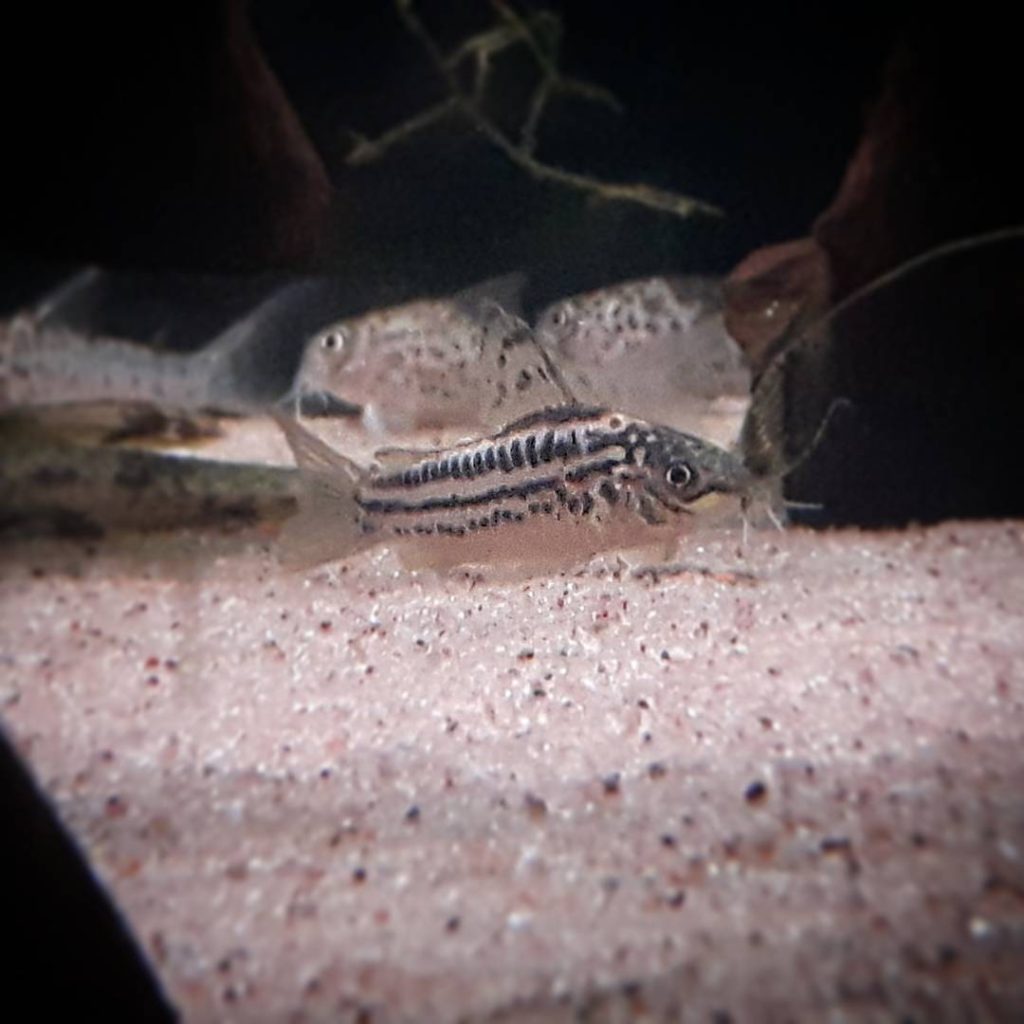
These creatures don’t grow very large, capping out at a modest maximum length of just 5.1 centimeters (2.0 inches). Such a size allows the Elegans Cory Cat to maintain a graceful presence within the aquatic community.
| Trait | Description |
|---|---|
| Body Coloration | Olive with gray and black markings |
| Longitudinal Stripes | Two dark stripes |
| Dorsal Fin Pattern | Gray speckles, occasional arching pattern |
| Body Shape | Sleek and slender, not tall in comparison |
| Eye Position | Set slightly lower on the head |
| Maximum Length | Up to 5.1 centimeters (2.0 inches) |
Their elegant structure combined with their unique markings contributes to a striking visual impact in any aquatic setting.
Behavior & Temperament
The Elegant Cory, known scientifically as Corydoras elegans, exhibits a gentle and amiable temperament in the home aquarium. They are neither fin nippers nor aggressive, choosing to live harmoniously alongside other peaceful inhabitants. As naturally social creatures, these corydoras thrive when in the company of their own kind, highlighting the importance of maintaining them in a group to ideally nurture their well-being and natural shoaling instincts.
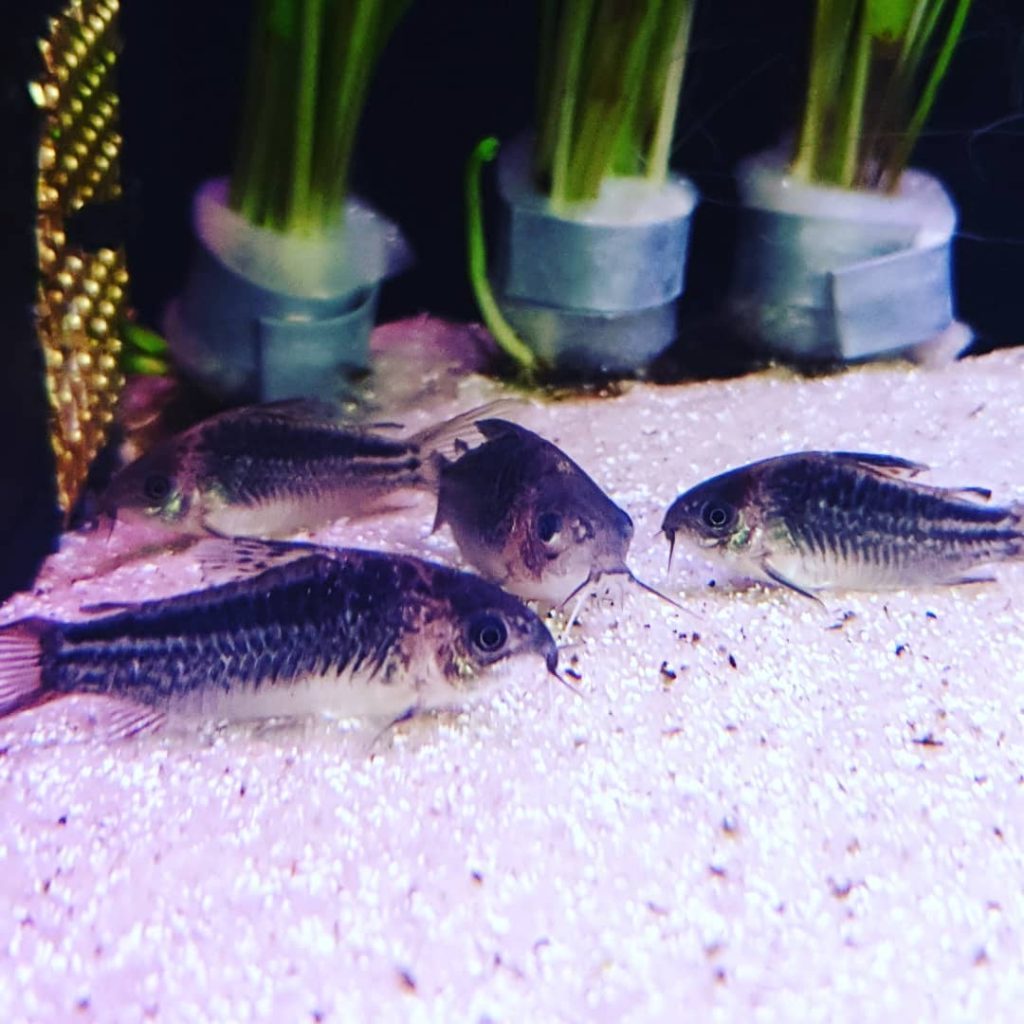
Are Elegant Cory Fin Nippers?
Elegant Corys are not known to engage in fin-nipping behavior. Their peaceful nature makes them excellent tank mates for a wide variety of fish species. They show no interest in nipping at the fins of other fish, making them a preferred choice for a community aquarium.
Are Elegant Cory Aggressive To Each Other & Other Fish?
When it comes to interactions with others, Elegant Corys are very much the peacemakers of the tank. They display no aggression towards other fish or even among themselves. Instead, they prefer to spend their time foraging together at the bottom of the tank as a cohesive unit.
Are Elegant Cory Friendly To Each Other & Other Fish?
The Elegant Corydoras are notably friendly, both with members of their species and with other peaceful fish. They can often be found in the company of other non-aggressive species such as tetras and rasboras, comfortably sharing their space. In a community tank, they exhibit a tranquil presence that complements their fellow inhabitants.
Are Elegant Cory Schooling Fish?
Yes, Elegant Corys are indeed schooling fish. In the wild, they can be found in large shoals, a behavior that is well-replicated in captivity. Keeping them in groups allows them to display their full range of natural behaviors, including synchronized swimming and playful interactions that delight onlookers.
Can You Have Just One Elegant Cory In The Tank?
While it is physically possible to keep just one Elegant Cory in a tank, it is not advisable. Without the company of their kind, a solitary Elegant Cory may become stressed and exhibit unnatural behavior. They truly flourish in a social setting where they can interact with their peers.
Do Elegant Cory Need To Be In Groups?
Elegant Corydoras have a definitive need to be kept in groups. A minimum of five individuals is recommended, but six or more is optimal. Group living conditions promote their health, reduce stress, and encourage a vibrant display of their natural schooling activity.
Summary Table
| Behavior Trait | Elegant Cory Description |
|---|---|
| Fin Nipping | Nonexistent – they are not fin nippers |
| Aggression | Non-aggressive to others |
| Friendliness | Friendly towards each other and others |
| Schooling | Natural schooling fish; best kept in groups |
| Solo Living | Not recommended, may lead to stress |
| Group Requirement | Minimum of 5 is essential, 6 or more ideal |
It is clear that Elegant Corys are truly communal fish that exhibit their best qualities when kept in an environment that mirrors their natural habitat—a peaceful setting where they can engage in the safety and social dynamics of a group.
Food & Diet
The Elegant Cory, also known as the Elegans Cory Cat, is an omnivorous species that requires a varied diet to maintain optimal health and vibrant coloration. To thrive, they should be offered a well-balanced diet that includes a mix of dried, flake, frozen, pellet, and live foods. Sinking dried pellets and foods like blackworms, daphnia, and brine shrimp are particularly enjoyed by these fish and are important for conditioning them for breeding. A balanced diet should also incorporate quality flake or pellet food as well as frozen fare such as brine shrimp and bloodworms. When caring for fry, baby brine shrimp or finely crushed flake food are suitable options to meet their nutritional needs.
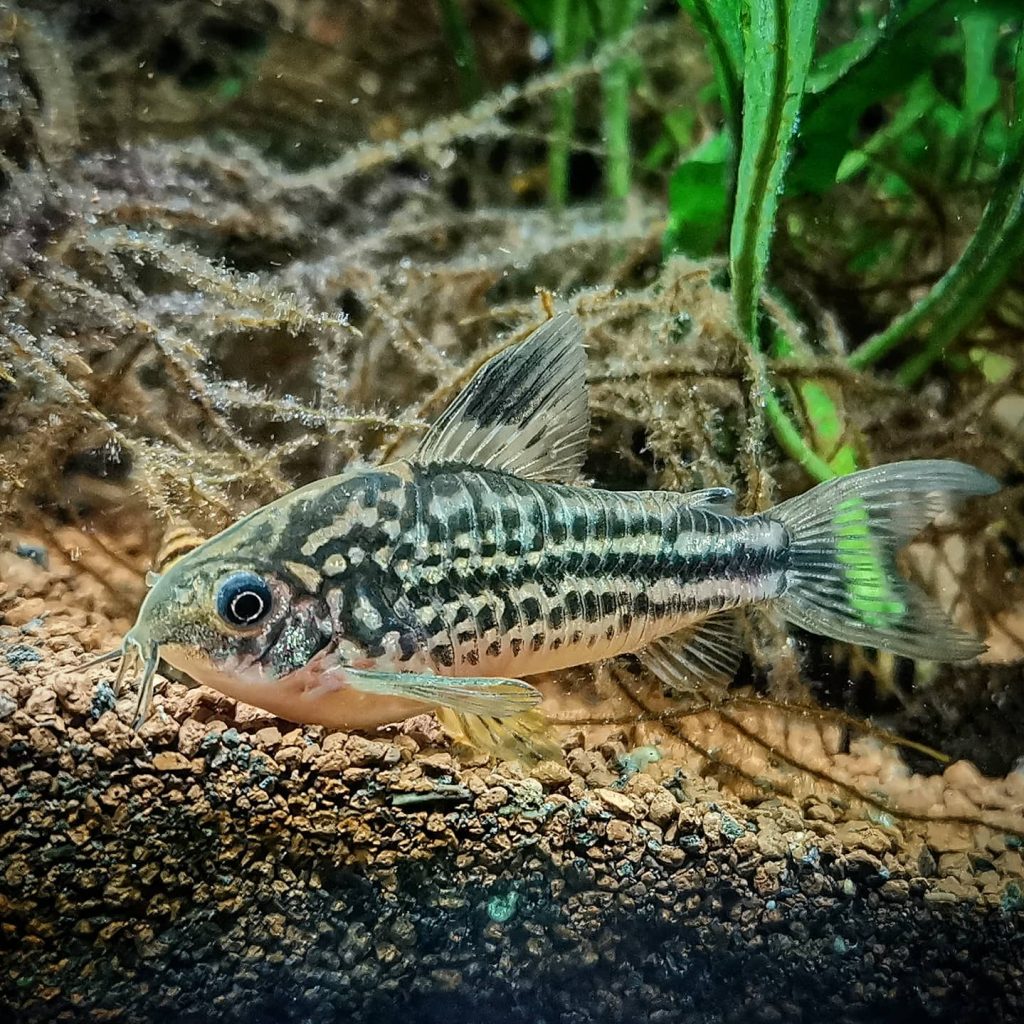
Do Elegant Cory Eat Algae?
While Elegant Corydoras will consume aufwuchs—which consists of algae and other microorganisms found on submerged surfaces—it is not their primary dietary focus. In an aquarium setting, they may occasionally graze on algae, but expecting them to keep an aquarium clean from algae would be a mistake. Thus, they should not be solely relied upon as algae eaters, and a well-rounded diet should be provided instead.
Do Elegant Cory Eat Shrimp?
Elegant Corydoras are not active shrimp hunters. Therefore, they pose little threat to adult shrimp in a community aquarium. However, it is possible for them to accidentally consume juvenile shrimp that are not cautious, although this is not a common occurrence. As such, they can coexist with shrimp populations without significant risk of predation.
Do Elegant Cory Eat Bloodworms?
Bloodworms are indeed a part of the Elegant Cory’s diet and are consumed with great enthusiasm. These worms provide a substantial amount of protein and are often used as a supplemental food that can help condition the fish for spawning. Nonetheless, a varied diet should be maintained to ensure the fish receive all the necessary nutrients.
Do Elegant Cory Eat Mosquito Larvae?
In their natural environments, Elegant Corys have been known to feed on mosquito larvae. Offering mosquito larvae as part of their diet in the aquarium can be beneficial, as it is rich in protein and mimics their natural feeding habits. Moreover, this can assist in keeping the mosquito population in check within the aquarium ecosystem, providing both nutritional and environmental advantages.
Do Elegant Cory Eat Planaria?
Elegant Corys do not specifically target planaria as a primary food source. Although these fish are opportunistic omnivores, planaria are not a significant part of their natural diet. As they forage for food, they may incidentally consume small organisms, but it is not common for them to actively seek out or rely on planaria for nutrition.
In summary, an Elegant Cory’s diet should be diverse and well-rounded, including both plant-based and animal-based foods, to mirror the nutritional richness of their natural ecosystems. While they may ingest a variety of foods due to their omnivorous nature, they do have preferences and it’s essential to cater to these in order to maintain their health and vitality in a home aquarium.
Do Elegant Cory Eat Plants?
Elegant Corydoras, while being omnivores, show a preference for animal-based foods. However, plant matter is still an essential part of their diet for optimal health. In their quest for food, they tend to vacuum algae and debris off the aquarium floor. Yet, they should not be considered as your primary solution for algae control in fish tanks, as their algae-eating capabilities are limited.
For a truly nutritious diet, it’s important to target-feed Elegant Corys with a variety of sinking foods. This includes pellets, wafers, as well as occasional treats of frozen or live foods to provide the necessary plant nutrients. Regularly incorporating long-lasting food options such as large pellets, wafers, or nutrient-rich formulations like Repashy gel food ensures that they remain healthy and content.
Since Elegant Corys are slower eaters, they benefit from the opportunity to graze over an extended period. Foods that remain intact for a few hours provide the best opportunity for these fish to eat at their natural pace, making sure they get the full nutritional benefits from both animal and plant-based components of their diet.
| Food Type | Purpose in Diet | Feeding Recommendation |
|---|---|---|
| Algae/gunk | Minor source of plant nutrition | Not effective for major algae control |
| Pellets | Staple diet component | Offer as part of regular feeding routine |
| Wafers | Long-lasting food source | Ideal for extended grazing |
| Repashy | Nutrient-rich, long-lasting plant | Provide regularly for optimal health |
| Frozen/live | High protein, occasional treat | Feed sparingly for variety and enrichment |
Sexing: Male vs Female
Understanding the differences between male and female Elegant Corydoras (Corydoras elegans) is essential for breeders and enthusiasts alike. Male Elegant Corys often exhibit a grey/green base color, adorned with a generous number of dark spots distributed across their bodies. In contrast, females feature fewer spots which are mostly confined to their fins.
Mature females in particular tend to be larger and exhibit a rounder profile, especially noticeable when viewed from above due to their expansive underbellies. Males, while generally shorter in length, boast more vibrant coloration and a greater intensity of dark markings, making them stand out in the aquatic environment.
During prespawning activities, males of the species may display territorial behavior, whereas females are often found seeking seclusion amongst the verdant concealment of plant roots within the breeding tank.
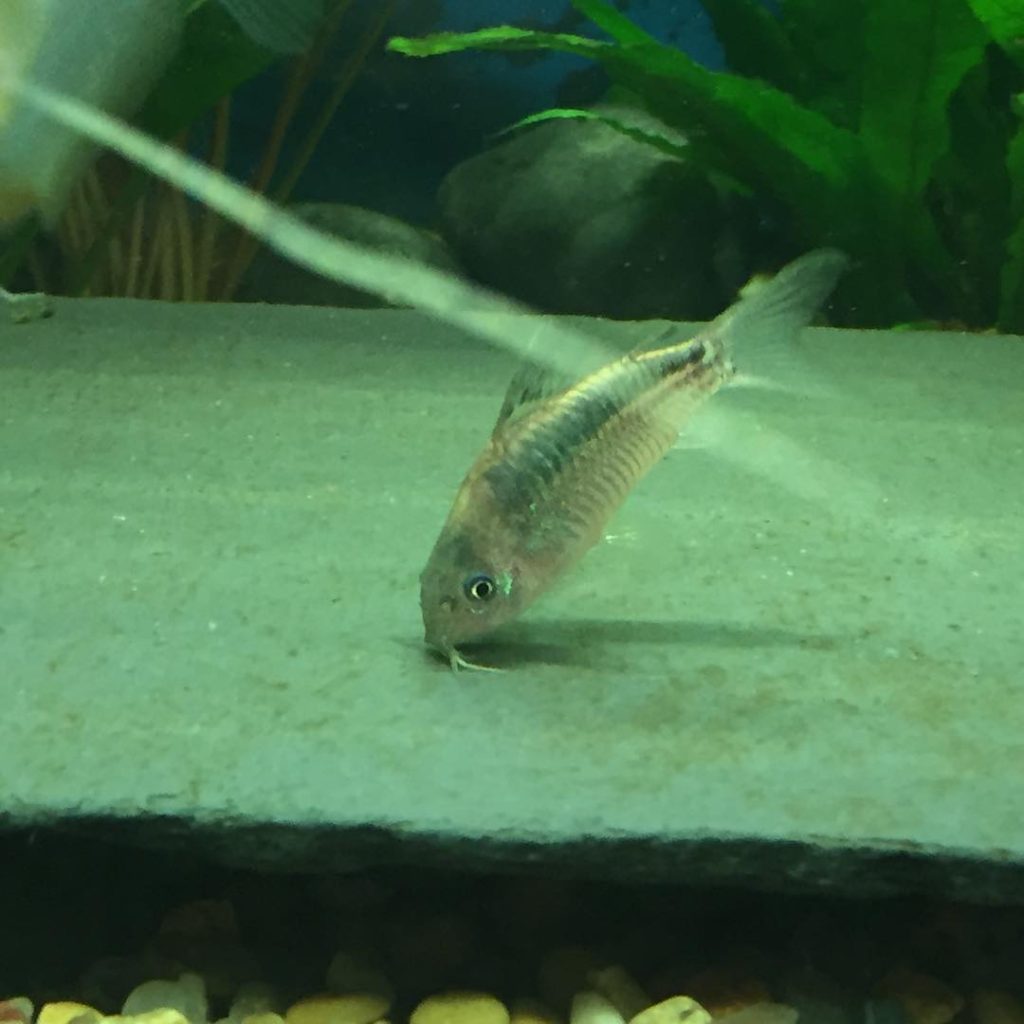
When conditioned well, distinguishing male from female Elegant Corys becomes more apparent, aiding in managing and understanding their breeding behaviors.
Use this quick reference table to differentiate Elegant Corydoras at a glance:
| Sex | Body Color | Markings | Body Shape | Behavior |
|---|---|---|---|---|
| Male | Grey/Green | Numerous dark spots | Shorter, slender | Territorial |
| Female | Same with spots | Spots mostly on fins | Larger, rounder | Hidden around roots |
Elegant cory Tank Mates
The Elegant Cory, scientifically known as Corydoras elegans, thrives in a community tank setting, building harmonious relationships with various peaceful tank mates. These sociable fish prefer the company of their kind and are best kept in small groups, creating an engaging display of schooling behavior.
Their gentle nature makes them excellent companions for a range of small to medium-sized fish, such as guppies, tetras, and danios. These corys can also share their space with loricariids or engage in friendly interactions with shrimps, adding to the diversity and ecological balance of the aquarium ecosystem.
However, aquarists should avoid housing Elegant Corys with crayfish. The territorial and potentially aggressive nature of crayfish poses a significant risk to the well-being of these armored catfish, as crayfish can cause injury, especially in confined spaces where they overlap territories.
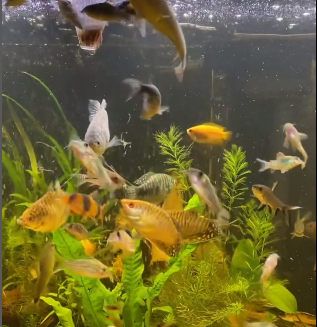
Elegant Corys adapt well to the omnivorous feeding patterns of their neighbors, showing a preference toward animal-based foods. This dietary flexibility allows for a broad range of tank mate options without disrupting the overall feeding regimen of the community tank.
Elegant Cory Tank Mates:
| Suitable Tank Mates | Unsuitable Tank Mates |
|---|---|
| Guppies | Crayfish |
| Tetras | Aggressive Species |
| Danios | |
| Loricariids (Suckermouth Catfish) | |
| Shrimps |
When creating an aquatic community, ensure the companions are chosen considering the peaceful and communal essence of the Elegant Cory.
Aquarium Setup
Creating the perfect aquarium setup for your Elegant Cory, also known as Corydoras elegans, is crucial for their health and general well-being. While these fish are known for their adaptability and peaceful nature, they do require a specific set of conditions to thrive in captivity. From tank size to water parameters, each element plays a vital role in simulating their natural habitat and ensuring their longevity.
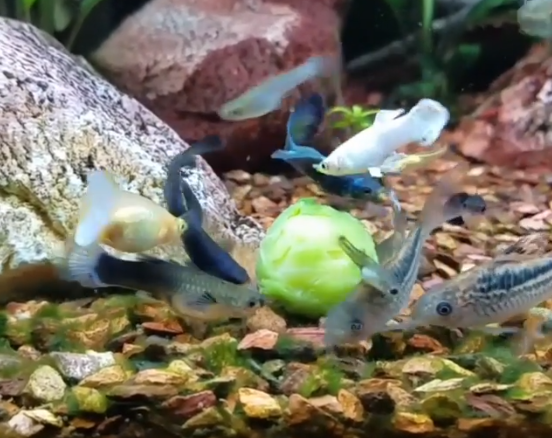
Ideal Tank Size
When considering tank size for your school of Elegant Corys, a minimum of 20 gallons is recommended. This volume of water provides ample space for a group of at least 5 fish—allowing for the natural schooling behavior that these catfish are known for. A larger tank not only offers a more stable aquatic environment but also enables their keepers to include more fish and aquatic plants, creating a diverse and engaging ecosystem. Keep in mind that a spacious tank also facilitates better water quality management, contributing to the overall health of your Elegant Corys.
Ideal Water Parameters
To match the natural South American waters where Elegant Corys come from, aim to maintain water hardness, or general hardness (GH), at 3 to 22, with carbonate hardness (KH) levels between 0 to 12. The pH levels should be kept within the slightly acidic to neutral range of 6 to 7.8. Additionally, temperature plays a critical role in their comfort, with an optimal range of 22 to 26°C. Consistency in these water parameters is key, as it is essential for promoting the longevity of your fish. They can live up to 10 years under the right conditions, so it is worthwhile to regularly test your water and adjust as necessary to maintain these levels.
Filtration
Efficient filtration is indispensable in an Elegant Cory tank. It aids in maintaining clear water and stabilizes water parameters, ensuring the removal of harmful waste and toxins. For these active bottom dwellers, who like to sift through the substrate, a filtration system that can handle the bioload without creating excessively strong currents is ideal. Hiding the unsightly mechanical parts of your filtration system can be aesthetically pleasing when you cleverly attach plants like Anubias to them, which serves to both disguise equipment and add natural beauty to your setup.
Lighting
When it comes to lighting, Elegant Corys are not overly demanding. However, lighting is essential for the growth of aquatic plants such as Aponogeton and Anubias, which are compatible with the Corys’ environment. Aponogeton plants thrive in low to moderate lighting conditions, making them versatile for various tank setups. Anubias plants, being tolerant of low light, can be placed in shadier parts of the tank or used to complement areas with lower exposure. Proper lighting not only supports plant health but also enhances the natural beauty of the aquarium, creating a serene environment for both fish and observer.
In summary, a well-thought-out aquarium setup that includes the right tank size, stable water parameters, efficient filtration, and suitable lighting ensures a healthy and stress-free environment for your Elegant Corys. Whether you’re a beginner or an expert aquarist, striking the right balance in these key aspects will lead to a thriving aquatic community.
Common Possible Diseases & Prevention
Common Possible Diseases & Prevention Tropical fish can be susceptible to a variety of health issues, ranging from bacterial infections to parasitic and worm infestations. These ailments can manifest as odd behavior, appetite loss, discolored scales, or wounds on the fish’s body. Observing your fish for such signs is crucial for early detection and treatment.
To safeguard the wellness of tropical fish such as the Elegant Cory, maintaining excellent tank hygiene is essential. Regular water changes, ensuring adequate space, and quarantining newcomers help prevent disease outbreaks. Moreover, providing a balanced diet keeps fish robust against health threats.
| Prevention Tips | Description |
|---|---|
| Tank Maintenance | Regular cleaning and water changes to remove waste. |
| Quarantine New Fish | Isolate new arrivals to avoid spreading diseases. |
| Balanced Nutrition | Offer a mix of flake, frozen, and pellet foods. |
| Avoid Overcrowding | Ensure sufficient space for each fish to reduce stress. |
If your fish show any distress signs, seek advice from a vet or seasoned aquarium enthusiast. Prompt care can often prevent more severe health issues and prolong the life of your Elegant Corys and other tropical fish companions.
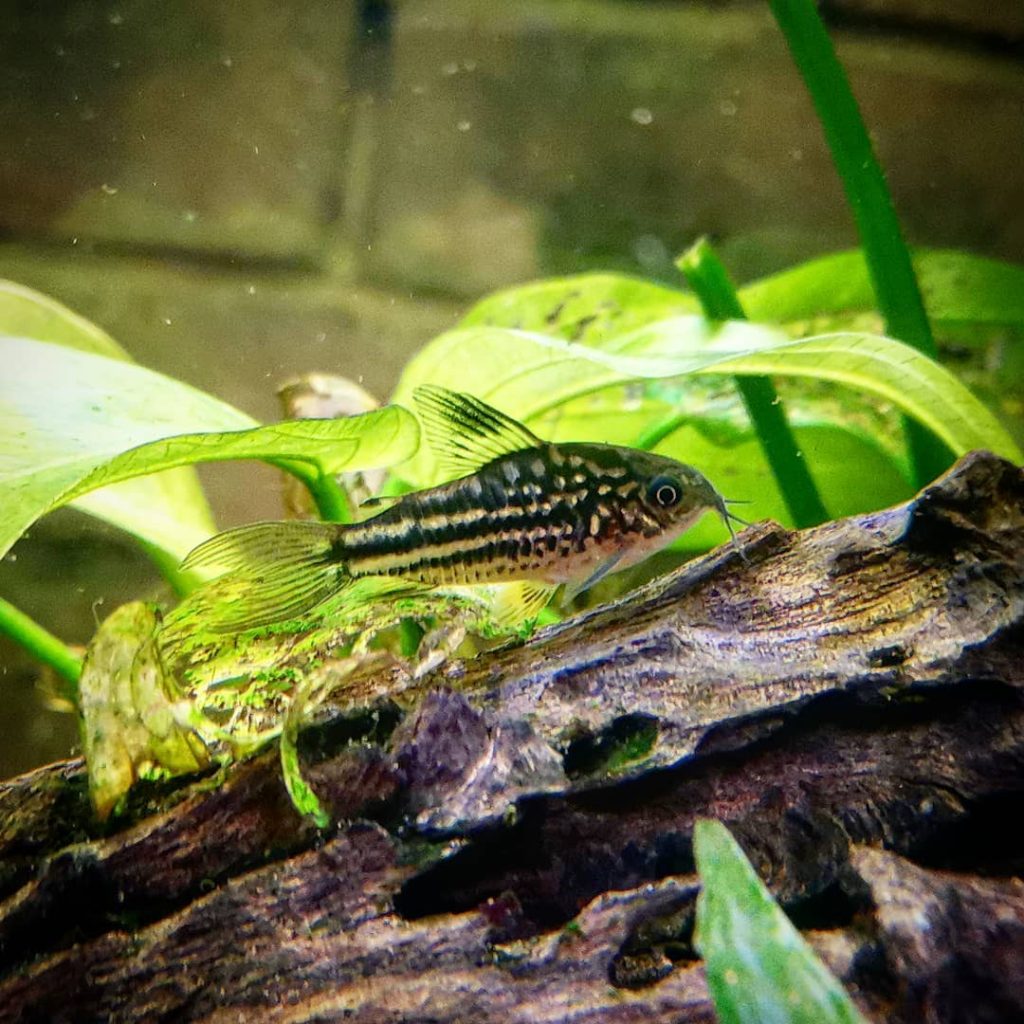
Breeding Elegant cory In Aquarium
To breed Elegant Corydoras cats, it’s important to replicate their natural conditions within your aquarium. Start by grouping several Elegant Corys together to allow them to naturally pair up for spawning. These fish are seasonal spawners, so simulating their breeding season is key. A significant water change with cooler water can mimic the onset of the rainy season, often triggering the spawning process.
Once mating occurs, female Elegant Corys will lay eggs. They are known to prefer attaching their sticky eggs to the underside of broadleaved plants. After the eggs are laid, fertilization occurs. Within approximately five days, the eggs hatch and become free-swimming.
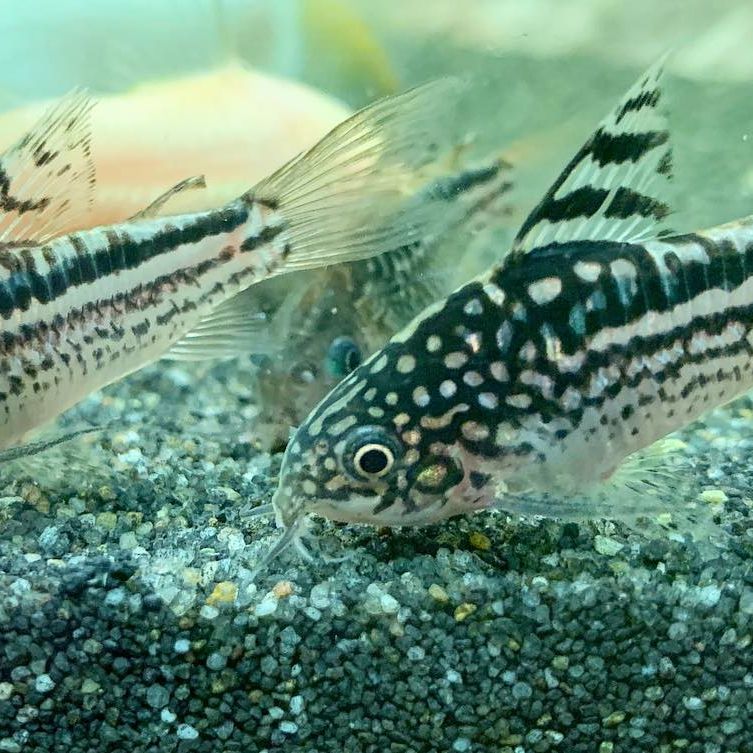
Feeding the new fry is critical for their development. Baby brine shrimp and crushed flake food are ideal first foods, providing the nutrition necessary for young fish to thrive.
| Breeding Steps | Tips |
|---|---|
| Provide a Group | Several Elegant Corys encourage natural pairing. |
| Simulate Rainy Season | Change water with cooler water to stimulate spawning. |
| Prepare for Eggs | Female lays adhesive eggs on preferred surfaces, like an underside of leaves. |
| Fertilization & Hatching | Eggs waterborne in about five days. |
| Feed the Fry | Offer baby brine shrimp or crushed flake food for nourishment. |
Following these guidelines and monitoring water parameters closely enhances the chances of successfully breeding Elegant Corys in your aquarium. Mature females and adult males will actively participate in the breeding process, ensuring the cycle continues. Always maintain a clean tank with appropriate gravel or sandy substrate to provide an optimal breeding environment.

